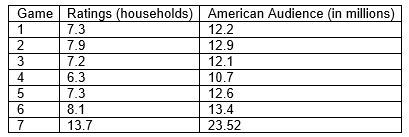In my last blog posting I presented an argument proposed by some people that National TV ratings should not be used to compare the popularity of the World Series (WS) to the popularity of the Super Bowl because the World Series is a regional event whereas the Super Bowl is a national event.
The 2014 World Series had Fox executives worrying about their National TV ratings. After all this would be the first WS involving two teams with fewer than 90 wins and with two teams that played in the additional wild card game instituted in 2012. Added to that negative was the fact that the AL representative was not the Red Sox or Yankees but was the small-market Kansas City Royals.
The first six games of the 2014 World Series were for the most part ho-hum. In fact, this was the first WS in history where at least five games were decided by five or more runs. The Giants won Game 1 behind a strong performance by Madison Bumgarner, while the Royals won Games 2 and 3, as their relief pitchers limited the Giants’ hitters. The Giants won Games 4 and 5, as they scored 11 runs in Game 4 and Bumgarner threw a complete game shutout in Game 5. The Royals came back to win Game 6 as they scored 10 runs and shut out the Giants, forcing a Game 7.
As expected the first six games drew awful ratings. In fact, the 2014 World Series set records for the lowest TV ratings for Games 1, 4, 5, and 6 in WS history. The ratings for the entire seven WS games are presented below.

Game 7 of the World Series, which brought the San Francisco Giants their third championship in five years, was seen on Wednesday night by 23.5 million viewers, the most to view a Series game since Game 7 in 2011, when 25.5 million watched St. Louis beat Texas. None of the first six games of this year’s WS had been seen by more than an average of 13.4 million viewers. Game 7 figures nearly doubled the ratings and viewership averages for Games 1 through Game 6 and kept the Series from supplanting 2012 as the lowest-rated Fall Classic on record.
What brought about the dramatic increase in ratings for Game 7? After two strong pitching appearances in Game 1 and Game 5 by Bumgarner, baseball people were intrigued about his possibilities for Game 7. With only two days rest would Bumgarner be used in Game 7? If he was used would he start or relieve? How many innings would he be allowed to pitch? Of course, the nature of the deciding factor of a championship determined by one game added to the excitement.
Game 7 viewership climbed steadily throughout the night. From 9:30 to 10 p.m. it stood at 23.5 million. But after Bumgarner’s entrance as a reliever for the Giants in the fifth inning, it rose through the last three half-hour periods, to 25.8 million, 26.3 million and 27.8 million. Through Tuesday, the matchup between the Giants and the Kansas City Royals was on pace to be the lowest-rated and least-viewed World Series on record.
After allowing a single in the fifth inning, Bumgarner retired 14 straight batters. Game 7 ended dramatically when Alex Gordon reached third base as the potential tying run with two outs in the ninth inning. Bumgarner induced Salvador Perez to hit a foul popup that was caught by Pablo Sandoval to end the game, and baseball season.
Still, the audience for the Series was smaller than the 14.9 million average during Boston’s six-game victory over St. Louis last year.
The Kansas City market had a 58.3 rating, setting a record there for a Major League Baseball game, but it was not a Nielsen-metered market in 1985, when the Royals won Game 7 against St. Louis in a broadcast seen by 45 million. San Francisco’s 38.8 rating was the best in that market since Game 7 of the 2002 World Series.
